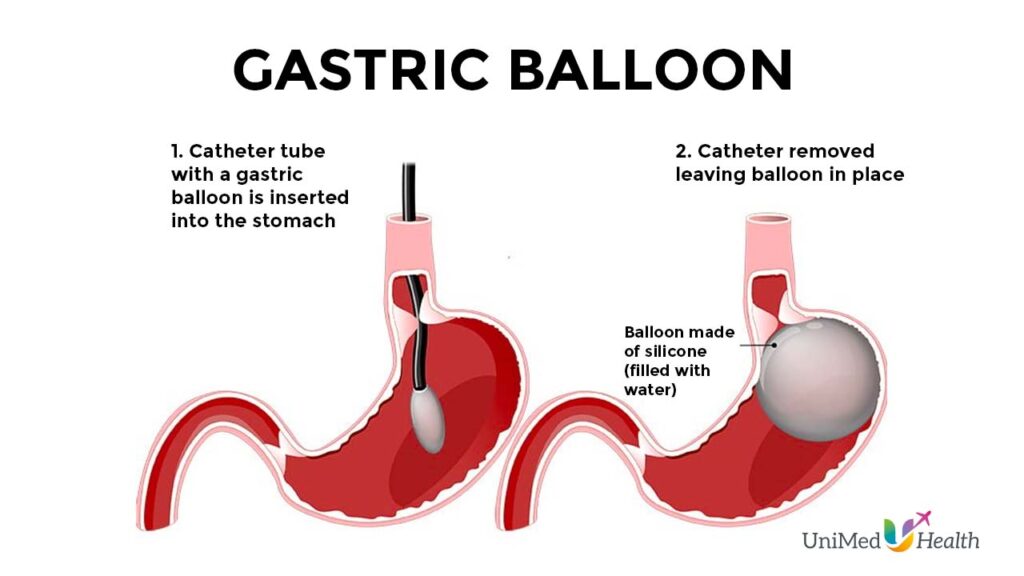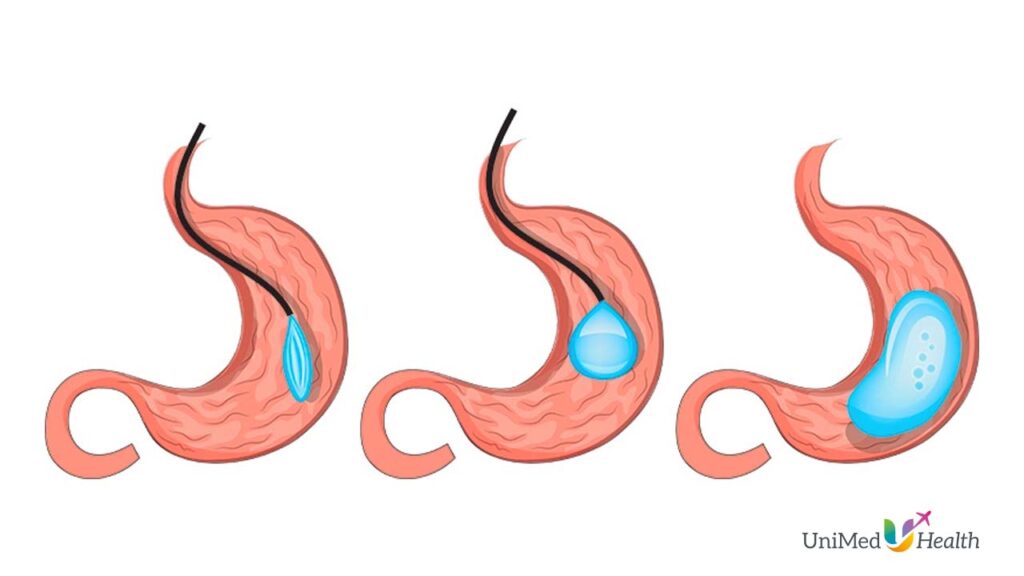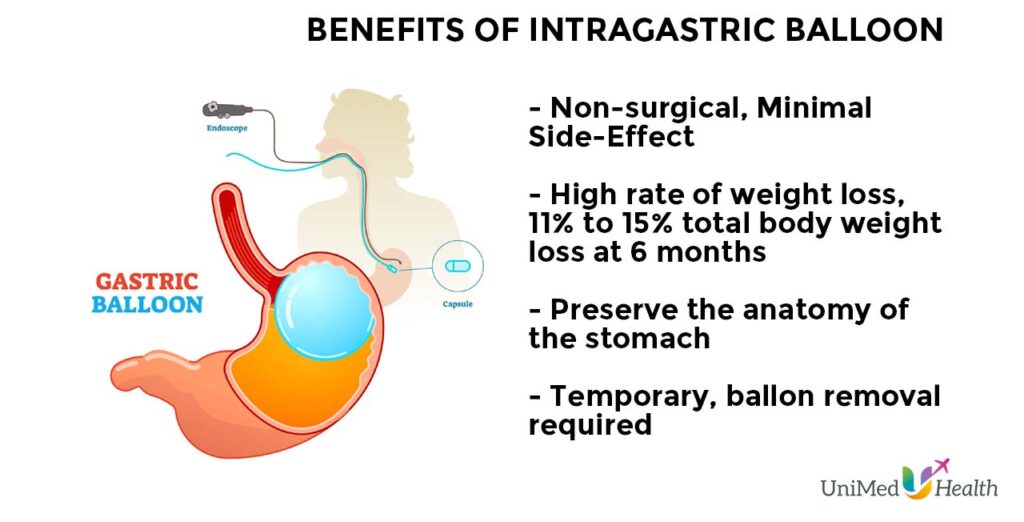GASTRIC (INTRAGASTRIC) BALLOON
Although the gastric balloon (also called an intragastric balloon) is considered as one of the bariatric surgeries, actually it is not a surgical procedure. It is a procedure performed endoscopically (it is the process of viewing the stomach with a sterile, thin tube with a camera at the end, sent from the patient’s esophagus). Unlike general anesthesia, patients are put to sleep with sedation during the procedure. Sedation is a more tolerable method than general anesthesia, and the patient does not need auxiliary equipment for breathing and does not feel or remember any pain during the procedure. It is much less invasive than sleeve gastrectomy or gastric bypass. A soft, latex-free intragastric balloon made of silicone or polyurethane is placed into the stomach of the patient endoscopically. Then the balloon placed in the stomach is inflated with air/gas or saline. The volume of the balloons is between 400-700 ml on average. When inflated, they cover one-third of your average stomach. Intragastric balloons stay in your stomach for an average of 6-12 months, depending on their type. In general, this procedure is preferred by patients who have not benefited from exercise and diet but do not want to have bariatric surgery and patients who cannot or do not want to take the risk of anesthesia. Like other bariatric surgeries, the intragastric balloon requires a lifelong commitment. To ensure long-term success, a healthy diet and exercise should be done.


How does it work?
Decreased stomach capacity: The inflated balloon reduces the stomach volume. It causes patients to feel full with smaller portions and become less hungry. Thus, it helps patients lose weight.
Difficulty in overeating: When patients overeat, they suffer from some indigestion problems. Thus, they have to reduce their portions.
Who is suitable for a gastric balloon and who is not?
- Patients aged 18-60 years
- If BMI is in the range of 30-40
- You are willing to commit to healthy lifestyle changes and have regular medical follow-up.
- If you have previous bariatric surgery experience.
- Patients who do not benefit from diet and exercise
- Patients who are not pregnant and do not have a pregnancy plan for 12 months
- Patients without alcohol and drug addiction
- Patients without gastric hernia, acid reflux, esophageal varices
- Patients who cannot adhere to post-operative lifestyle changes, diet, and exercise plan
- If you have alcohol and substance abuse
- If the patient has a large gastric hernia, or significant acid reflux before the operation
- Psychosis, major depression, psychiatrically unstable patients
- Patients who have had previous open abdominal surgery or bariatric surgery
- Pregnant or 12-month pregnancy plan
- Patients with diseases such as esophageal varices, stomach ulcers, atresia, and stenosis are not suitable for intragastric balloons.
Surgery time and recovery process
The gastric balloon is a procedure that takes an average of 30 minutes. Patients stay in the hospital for an average of one day or can be discharged after the procedure. They can return to their working life within 2 to 5 days. Patients can exercise after gastric balloon, but avoiding heavy exercise for 2-3 weeks is recommended. During the post-operative recovery period, you may have stomach-related symptoms due to the nature of the surgery. During this period, you can use gastric protective drugs to relieve reflux symptoms with your doctor’s advice.
Diet and Eating Habits After Gastric Balloon
After the gastric balloon, patients will consume liquid foods for 3 days. Solid foods can be consumed within 2 weeks after consumption of semi-solid foods, respectively. If patients want to lose weight effectively after gastric balloon, they should follow a strict diet plan with a strict dietitian. Healthy, high-protein, fat-free foods that will not increase the patient’s post-operative dyspeptic complaints should be preferred. He should pay attention to fluid consumption after the operation and should not consume too much coffee and carbonated drinks that will increase reflux. Smoking should be stopped or limited. Food should not be eaten before going to bed. A minimum of two hours should be allowed. Meals should be eaten slowly and chewed well. It should be noted that intragastric balloon operation is for patients who will stick to these plans. If you want to learn more about pre-op and post-op diets, you can visit.
Gastric Balloon Advantages
The gastric balloon has its pros and cons in every procedure. In terms of effectiveness, weight loss, and overall success, it appears to be inferior to studies conducted with sleeve gastrectomy and gastric bypass. However, It has many advantages as listed below.
- Quicker procedure (30 minutes)
- Does not require anesthesia
- Preservation of natural body physiology and anatomy
- Having the option of removing a temporary device if desired.
- Less serious complications compared to invasive surgery
- Shorter recovery time (2-5 days)
- When combined with a diet and exercise program, incredible long-term results are seen, and it is accompanied by weight loss in a short time.

Benefits of the gastric balloon on obesity-related conditions
A gastric balloon gives you weight loss with a strict diet plan and exercise. According to studies, it has lower remission rates compared to sleeve gastrectomy and gastric bypass in obesity-related diseases. However, if combined with diet in the long term, its effects cannot be ignored.
Weight loss after gastric balloon
Patients lose 10-15% of their body weight in about 4 months. According to studies, the period in which patients lose the most weight is 6 months. According to some studies, it has been shown that patients lost 30 to 35% of their excess weight at the end of 6 months. Long-term outcomes are determined by patients’ adherence to their new lifestyle.
How long does the gastric balloon remain in the body and how is it removed?
Our bariatric surgeons, who are experts in this field, determine the residence time of the gastric balloon. While doing this, they take into account your health and weight loss. However, according to balloon brands, some balloons can stay in the body for 6 months, and some balloons can stay in the body for 12 months. This information is detailed in the relevant section. Removal of the balloon is also performed endoscopically. The liquid or gas in the balloon is discharged, then the balloon is removed with a special holder. This procedure should be performed by bariatric surgeons.
